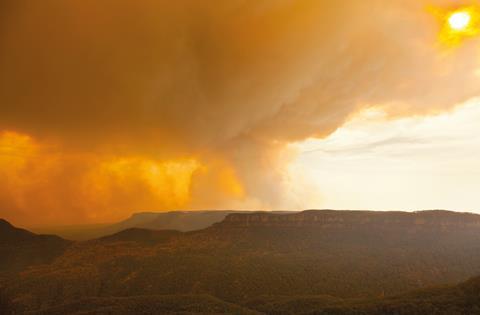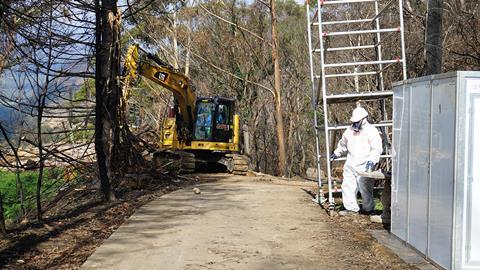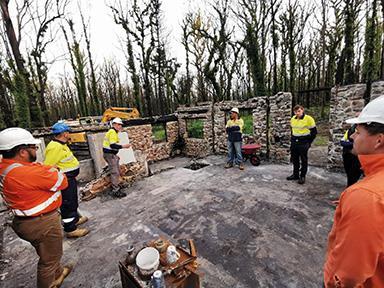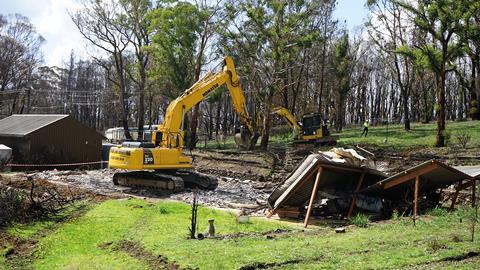Coronavirus hit an Australia still smouldering from the devastating bushfires of the summer. And for the teams working to clear the ruination, the challenge suddenly got a lot harder

Before covid-19 gripped the globe, images of Australia ablaze had the world transfixed. The place many call “the lucky country” looked as if it was being razed to the ground.
As an Australian living in London, for me images of the country’s largest ever bushfires brought back memories of driving through Kinglake, an area in Victoria ravaged by the Black Saturday bushfires in 2009. Claiming 173 lives, they were the deadliest fires in Australia’s history. No one who was there at the time could forget the smell of smoke that lingered over Melbourne, my home city.
Almost a decade later, the damage caused by those bushfires in 2009 is still undeniable. On a trip back home earlier this year, I was struck by how much of the bush around Kinglake still appears ghostly, the gum trees badly charred. Driving the one winding road into town, it is not hard to imagine how terrifying it must have been trying to evacuate as the smoke grew thicker.
But what this trip also showed me was what can be rebuilt from the ashes. The bush, while charred, has regrown, and local people have spent the past decade rebuilding Kinglake township and their homes.
The challenge to rebuild is now facing huge swathes of Australia, after the most recent bushfires ravaged an area equal to more than half the UK. Some 186,360km2 burned in the fires of the latest Australian summer, which ran from last December into the first three months of 2020.
While the country will not recover quickly from these fires – which claimed the lives of 34 people and more than a billion animals, as well as destroying more than 3,500 homes and thousands of other buildings – the effort has begun and is expected to cost hundreds of millions of Australian dollars.
Rebuilding after such a disaster was never going to be easy. But then on 25 January Australia reported its first coronavirus case, and 47 days later the country went into lockdown. How does a country rebuild itself while in the midst of a global pandemic?
The initial challenge in New South Wales
In New South Wales (NSW), which is home to Sydney and is the state worst affected by this year’s fires, the federal and state governments have tasked Laing O’Rourke with leading the bushfire clean-up. The programme spans the entire state, from the northernmost tip near Byron Bay right down to the Victorian border, and the contractor must now navigate its challenges while dealing with the additional pressures of the pandemic.
We are working with people who have experienced a traumatic event, and getting the clean-up completed as quickly as possible is a huge step forward towards recovery
Paul Barrie, Laing O’Rourke
Speaking back in January, when dozens of fires were still burning, NSW premier Gladys Berejiklian said it was obvious the clean-up was not going to be a simple task: “The destruction caused by these fires is unprecedented and the process of recovery and rebuilding will take time.”
Laing O’Rourke, which was appointed as the managing contractor in late January, is working across 437 localities, spread over 45 local government areas.
The man in charge is Paul Barrie, Laing O’Rourke project director of the NSW bushfire clean-up programme. He says: “The NSW bushfire clean-up is a mammoth task, involving the clean-up of close to 4,000 properties across a project area that is one-and-a-half times the length of the UK.
“Every day we are working with people who have experienced a traumatic event, and we know that getting the clean-up completed as quickly as possible is a huge step forward towards recovery.”
Laing O’Rourke will directly employ more than 200 people, working across 14 offices – seven main regional offices and seven satellite offices that will move around the project area. Over the life of the project, which is due to be largely complete by July, the firm expects to have cleared around 4,000 structures. And all of this must be carried out before the rebuilding process can begin in earnest.
The firm is working to clear destroyed or damaged properties that are primary residences or places of business, safely removing all debris. This work includes the removal of hazardous trees, concrete slab foundations and known hazardous materials such as asbestos – which is not uncommon in the settings of much of the destruction.

About 40% of affected homes on the South Coast are expected to have asbestos, and the additional precautions required to manage asbestos could slow the clean-up. Moreover, Laing O’Rourke says finding local contractors equipped to deal with asbestos is proving to be a challenge.
The firm is prioritising working with local contractors wherever possible, in an effort to boost the economy of areas effectively shut down by the double whammy of the fires and covid-19. But there are not always contractors available in a local community with the skills and expertise to assist in the endeavour.
The logistical challenges
Aside from the physical difficulties of carrying out the work, the project faces a host of logistical headaches. First and foremost, the clean-up is an opt-in service and owners must register their property to be cleared, so it is vital to ensure widespread knowledge of the service and how to access it – but this has been a challenge.
To plan work most effectively and for maximum productivity, the firm needs property owners to register their properties as early as possible. To achieve this Laing O’Rourke has set up a dedicated call centre that is always staffed by eight people, though this number has been increased during the coronavirus crisis. It receives in excess of 200 calls a day.
Cameron Foord, senior project manager at Elton Consulting, who runs the call centre, says the team do not underestimate the significance of their role. “So far, our team has responded to over 3,000 calls received through the project hotline. Most calls take around 20 minutes, but it’s not uncommon for a call to last more than one hour. It’s a privilege to be able to help people that have been impacted by the bushfires, but it’s also a big responsibility.
“It’s been a deeply touching experience for all team members; the stories we hear about how people and communities have responded to the crisis are inspirational.”
There are also up to 3,000 emails sent each week to ensure registered property owners are kept informed of key stages of progress, and a project website has been set up to share updates and future work plans.
As the coronavirus took hold, the firm was booking more than 200 inspections of fire affected properties a week to determine what works needs to be done. Some of these inspections can take days to complete – partly because of the destruction of roads and bridges by the bushfires and subsequent floods, which have also left some communications still out of service. One community on the North Coast, which includes towns such as Byron Bay, took three days to access.

The issue of access is also a significant logistical hurdle in dealing with the products of the clearance work. The project by its nature, given that it centres on clearing fire-damaged property, will produce a significant amount of waste to be removed. Laing O’Rourke anticipates the total amount of waste produced to be more than 500,000m3, which will need to be collected and disposed of within a very short time.
To remove all this waste, haulage trucks will travel about 64 million km over the life of the project. The firm is in the process of engaging with 18 different waste sites across the state to ensure there is adequate capacity.
The challenge in NSW was summed up by the state’s deputy premier and minister responsible for disaster recovery, John Barilaro. In January he said: “With 2,399 homes destroyed and more than 10,000 buildings damaged or destroyed all up, we have a long journey ahead of us.
“Our emergency services, volunteers and our farmers have been outstanding in emergency situations these past months, and we need to be as vigilant in recovery as they have been in the face of disaster.”
And the number of destroyed properties has only increased since then.
Dealing with a crisis in a crisis
Covid-19 is having a significant impact on all parts of life at the moment, and the clean-up programme for the bushfires is no exception – particularly given the need for Laing O’Rourke to engage with local communities. While the virus introduced a new and obvious challenge to the recovery, Laing O’Rourke and the NSW government have been determined to maintain momentum in the programme.
Barrie says despite the challenges introduced by covid-19, the team still feel the responsibility to get people’s property ready to start their recovery. He says: “This meant we needed to put in place the right mitigations to protect our people and the community, while ensuring we kept the job kept going.
“We were able to quickly implement some new ways of working – like engaging with subbies online, installing handwashing stations on our vehicles, enforcing social distancing protocols and increasing cleaning practices – to adapt to this ‘new normal’ without delaying our important work.”

Since the outbreak began, the teams on the ground who are speaking to property owners and conducting inspections have implemented a range of precautions to ensure the safety of residents and the project team. These include additional screening questions during the initial phone conversation to help mitigate the spread of covid-19 and of course practising social distancing, ensuring Laing O’Rourke representatives stay at least the Australian regulatory minimum of 1.5m away from property owners when attending a property. Staff have also been required to carry out strict personal hygiene measures as well as regular sanitising of tools, including pens and clipboards.
When it comes to teams delivering the work, Laing O’Rourke has put in place a number of new safety measures to mitigate the spread of covid-19 while clearance works are undertaken.These include additional screening and health checks for local subcontractors before contracts are let and site inductions that include protocols specific to covid-19. Employees have also been told to carry out meetings over the phone wherever possible.
On a project like this, where whole communities have been destroyed, local buy-in is a must. But with community information sessions and town hall meetings no longer possible, this has been an unexpectedly big challenge.
Laing O’Rourke has been working closely with local councils and community groups to identify alternative ways of communicating to the broader community. These include online information sessions, webinars, and one-to-one meetings conducted at a safe distance in an appropriate location.
The restrictions in NSW – where at the time of writing there had been 3,089 covid-19 cases and 50 deaths, the most of any Australian state – were were eased significantly on 15 May, allowing for public gatherings of up to 10 people.
Progress to date
The focus now is on ramping up the clearing process. When the coronavirus struck, the firm was clearing about 80 properties a week. There is a plan in place that over the coming weeks and months this will increase to a point where more than 350 properties a week can be cleared. This number now stands at 300.
Barrie says: “In just a few months our teams have inspected more than 2,500 properties and we have made huge progress cleaning up 1,300 to date. With momentum building on the project, we are clearing almost 300 properties a week across suburban and remote communities. And while there is still a lot more work to do, we’re very pleased to already see a number of families begin to rebuild their homes and businesses.”

Since 7 May, clearance work has begun in 345 localities across 29 regions – with plans for more locations to start work in the coming weeks – a sign of the true scope of the work ahead.
And while the project certainly has its challenges, both expected ones and the unprecedented challenge of the covid-19 pandemic, its end goal is simple.
Looking now at Kinglake and Marysville, both of which were razed to the ground back in 2009, these are vibrant communities. And while there are concerns these towns could easily fall victim to another fire, the rebuilding process has brought unique opportunities.
Perhaps the most important of these is the opportunity to rethink housing design to build in bushfire resistance. For instance, it is important that the roof is designed to avoid potential valleys where embers can be trapped, so ideally a roof should be pitched, with a slope either side. Fire Protection Association Australia also says that while a metal or fibre cement roof is suitable, a tiled roof should be fully sarked to prevent embers from entering. PVC cladding should not be used. It is also advisable to avoid building on the top of a hill, because fires move faster and become more intense when travelling uphill.
The rebuilding process also brings other opportunities for improvement, such as reconsidering town planning and the routes in and out of towns, as well as ways to diversify local economies. The hope now is that the wider swathes of Australia destroyed in the latest bushfires may also benefit from such opportunities, rebuilding communities to greater vibrancy and resilience.
Hopefully on my next visit back to the lucky country, it will feel luckier again.
How the clean-up is boosting local businesses
A by-product of the bushfires, subsequent floods and the coronavirus pandemic is that regional and local economies across Australia which would usually benefit from tourism are suffering.
Local campaigns, including Road Trip for Good, which encouraged domestic tourism to stimulate the economies of bushfire-affected towns, have fallen away due to border closures and lockdown measures implemented to counter the pandemic.
But the bushfire clearance project is an opportunity for local economies seeking to recover from the disaster of the bushfire season, with Laing O’Rourke redesigning its procurement strategy to engage smaller local businesses.
About 80% of clean-up contracts awarded so far have been to small and medium-sized firms, while the firm has also made efforts to engage the Indigenous population. Three contracts have been awarded to local Indigenous businesses, while Laing O’Rourke is working to locate additional qualified Indigenous suppliers to be involved in the project and matching them to other companies in the supply chain.
Given the size and geographical location of many of these firms, it is the first time many of them have worked directly with a tier 1 contractor, presenting them with an opportunity to develop the skills and capacity to engage in major infrastructure projects in the future – something that will continue to stimulate local economies once the clean-up programme is complete.
Laing O’Rourke has implemented a series of initiatives to make the procurement process less daunting for firms new to working with large contractors. These include a weekly supply chain payment cycle that enables payment within seven business days following submission of a payment claim – helping to get money into regional communities and supporting jobs more quickly.
The subcontract suites have also been overhauled, with the language simplified and onerous conditions removed. Laing O’Rourke has also developed standardised pricing schedules and scopes of works to reduce supply chain tendering time and make evaluations faster and transparent.




























No comments yet